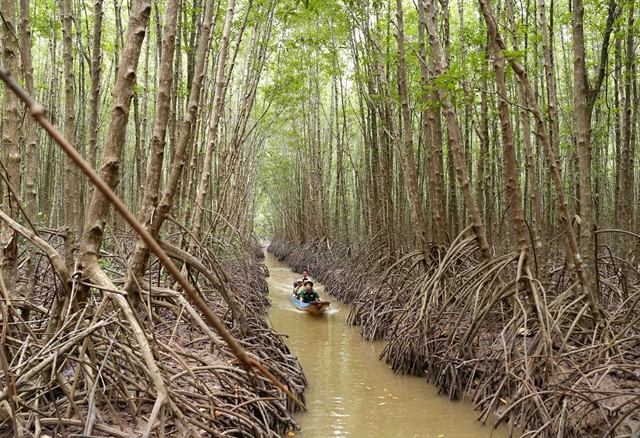 Society
Society

 |
| A mangrove forest in Cà Mau Province’s Ngọc Hiển District. Cà Mau is one of the Cửu Long (Mekong) Delta provinces with an extensive shrimp-forest farming model. VNA/VNS Photo Vũ Sinh |
HCM CITY – More and more farmers in the Cửu Long (Mekong) Delta are farming aquatic creatures using nature-based models that produce clean products, protect the environment and help adapt to climate change.
They farm shrimp and other creatures in forests and rice fields.
With its long coastline, the delta has excellent conditions for farming shrimp, crab, fish and clam in mudflats and mangrove forests.
In the southernmost province of Cà Mau, farmers have bred shrimp in mangrove forests, and this harmonises economic development with protection of forests.
Tăng Kim Ngân in Ngọc Hiển District’s Rạch Rốc Town has adopted the shrimp-forest farming model under a contract with a company and is paid a sum of money each year for protecting the forest.
Besides, shrimp bred under this model fetches 5-10 per cent higher prices.
“[It] is environmentally sustainable,” he said.
The model does not involve the use of chemicals, and the crustaceans eat natural foods found in mangrove forests and are thus organic.
More and more seafood processing companies in the delta have embraced it as it produces clean shrimp for export.
They have co-operated with local forest management agencies, localities and households tending forests to expand the model in recent years.
Cà Mau, the country’s largest shrimp producer, has more than 80,000ha of forests where the crustaceans are farmed, including 19,000ha with international quality certificates such as GlobalGAP, Global Aquaculture Stewardship Council (ASC) and Best Aquaculture Practices (BAP), according to its Department of Agriculture and Rural Development.
According to Phan Hoàng Vũ, director of the department, companies participating in the model are paid a forest environmental service fee of VNĐ250,000-500,000 (US$10-20) per hectare annually and provided with high-quality shrimp for breeding.
The province also teaches farmers new techniques to implement and expand the model to adapt to climate change.
It has zoned aquaculture areas along the coast, focusing mostly on shrimp and crab, and plans to develop the shrimp-forest farming model together with tourism.
In Trà Vinh Province, farmers in the coastal districts of Duyên Hải, Cầu Ngang and Châu Thành and Duyên Hải Town are expanding the farming of shrimp, crab and other marine species in mangrove forests.
Huỳnh Văn Tài in Duyên Hải District’s Long Vĩnh Commune has been breeding black tiger shrimps and mud crabs in his mangrove forests for five years.
He earns around VNĐ350 million ($14,700) a year from them.
Of his four-hectare farm, 40 per cent has mangrove trees and the rest has aquaculture ponds.
Trà Vinh has more than 9,000ha of forests, mostly mangrove, of which more than 4,000ha were planted by local households who breed shrimp and other aquatic species in the forests, according to its Department of Agriculture and Rural Development.
Farmers in the delta’s coastal areas have also developed shrimp-rice farming model in which they grow rice in the rainy season and farm shrimp in the dry season on the same field.
Rice fields in coastal areas are normally affected by saltwater entering rivers from the sea in the dry season, making them unsuitable for rice but ideal for shrimp.
The shrimp-rice farming model is sustainable and environment-friendly as farmers use few chemicals for either.
The delta has more than 160,000ha under shrimp-rice farming, mostly in Kiên Giang, Cà Mau, Bạc Liêu, and Sóc Trăng provinces.
Kiên Giang, the country’s largest rice producer, has more than 62,500ha to lead the delta in terms of the shrimp-rice farming area.
The province has in recent years been increasingly shifting from monoculture rice to the shrimp-paddy model in coastal areas.
The latter fetches farmers VNĐ110 million ($4,600) per hectare per year, three or four times the income from monoculture rice, according to the province People’s Committee.
Fragrant rice varieties like ST24 and ST25, two of the world’s best, are grown on 80 per cent of the area.
Nguyễn Văn Thắng in Vĩnh Thuận District has begun growing ST 25 rice on a 5,000sq.m shrimp-rice field this year and earned VNĐ20 million ($840).
“I will expand farming of the ST 24 and ST 25 varieties in my family farm and tell my relatives to switch to grow them as they are the world’s best rice and meet market requirements,” he said.
The shrimp-rice farming model was developed by the delta’s farmers decades ago and the model is helpful in adapting to climate change.
Under its fisheries development strategy for the period until 2030, the Government has encouraged the development of organic and nature-based aquaculture models and the application of good agricultural practices (GAP) standards to enhance product value and improve sustainability.
The delta is the country’s largest seafood producer. – VNS




